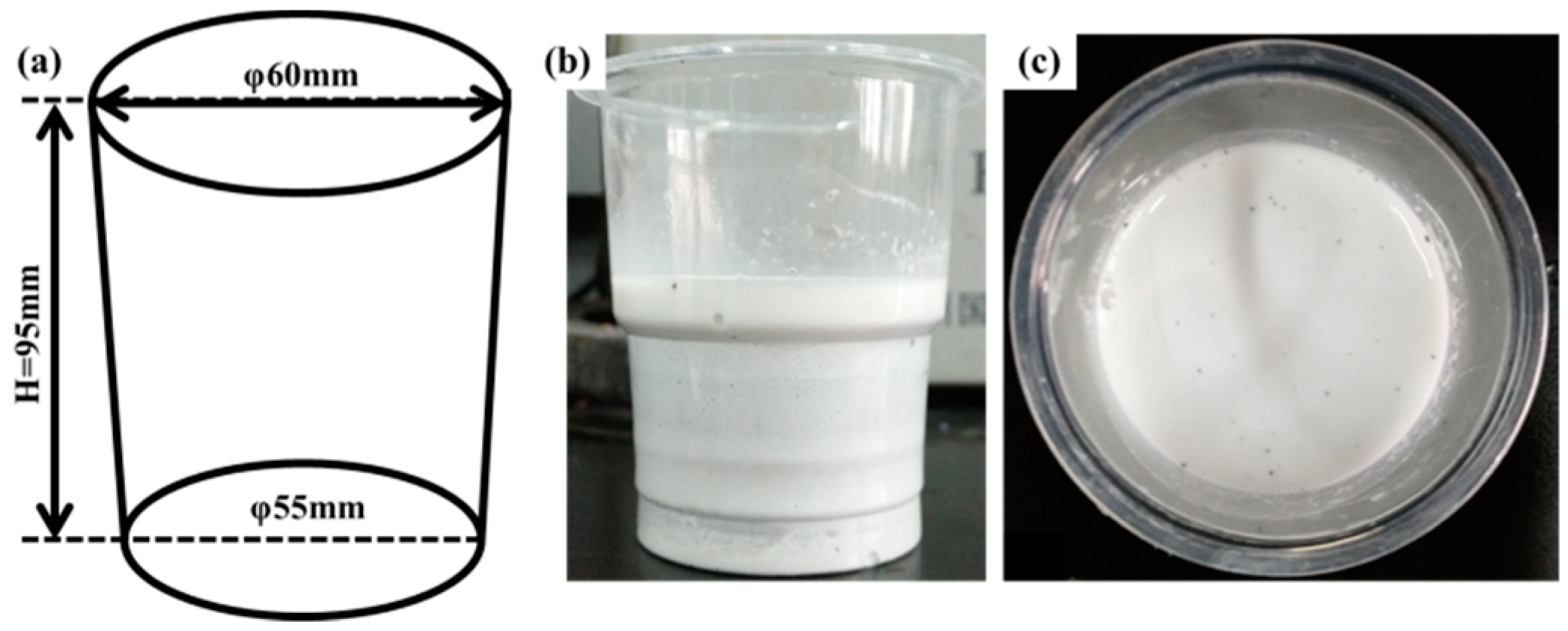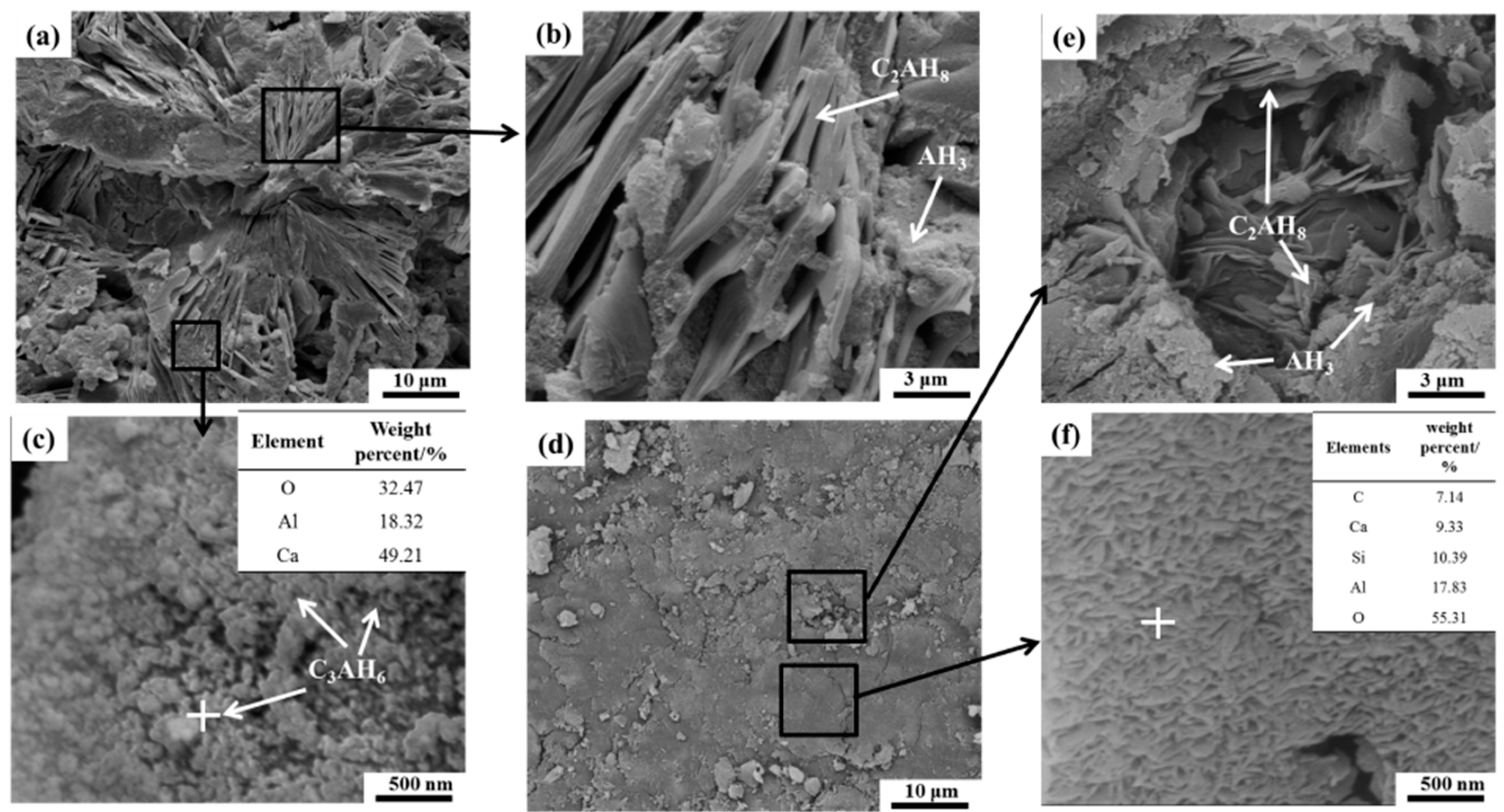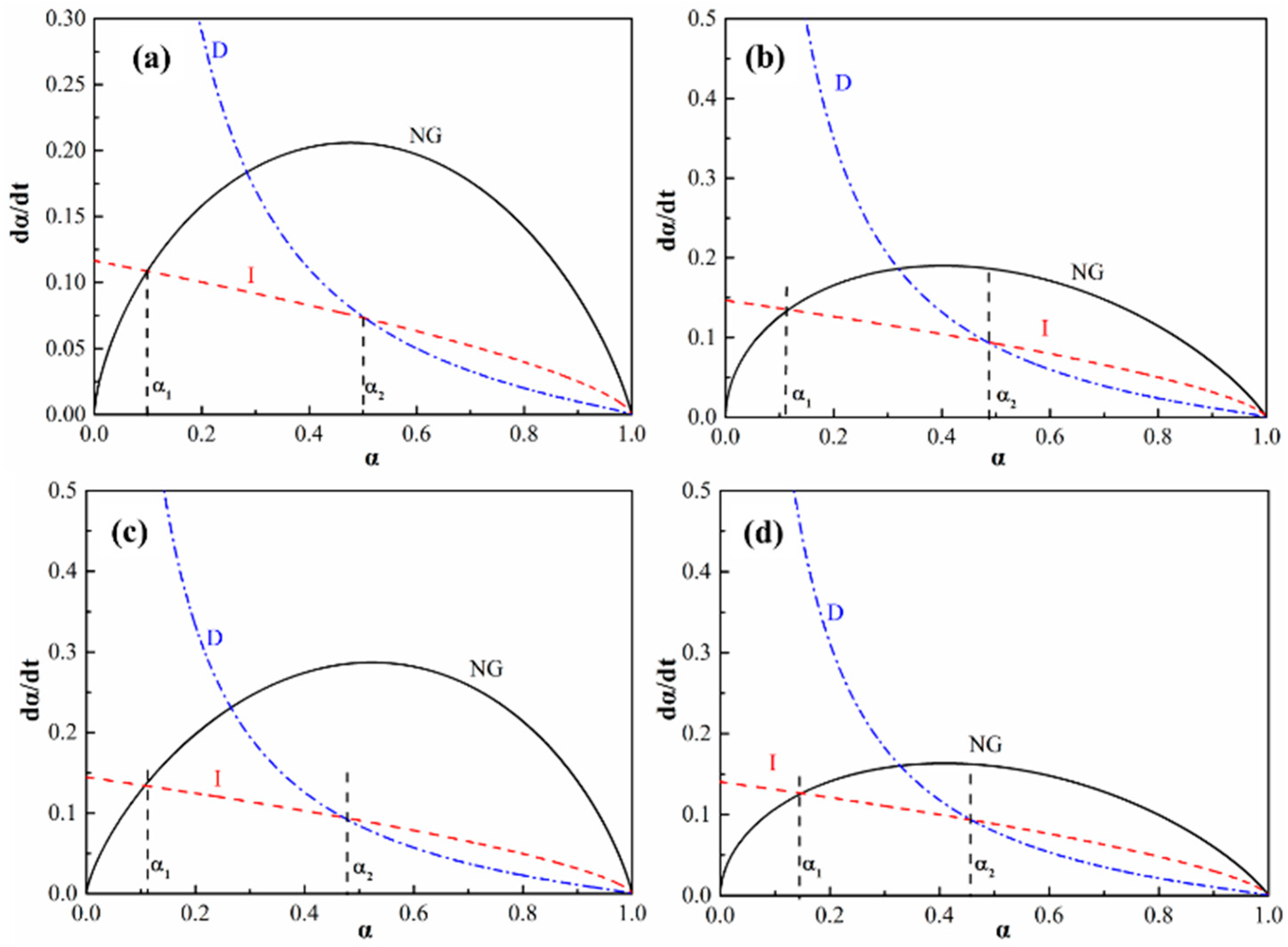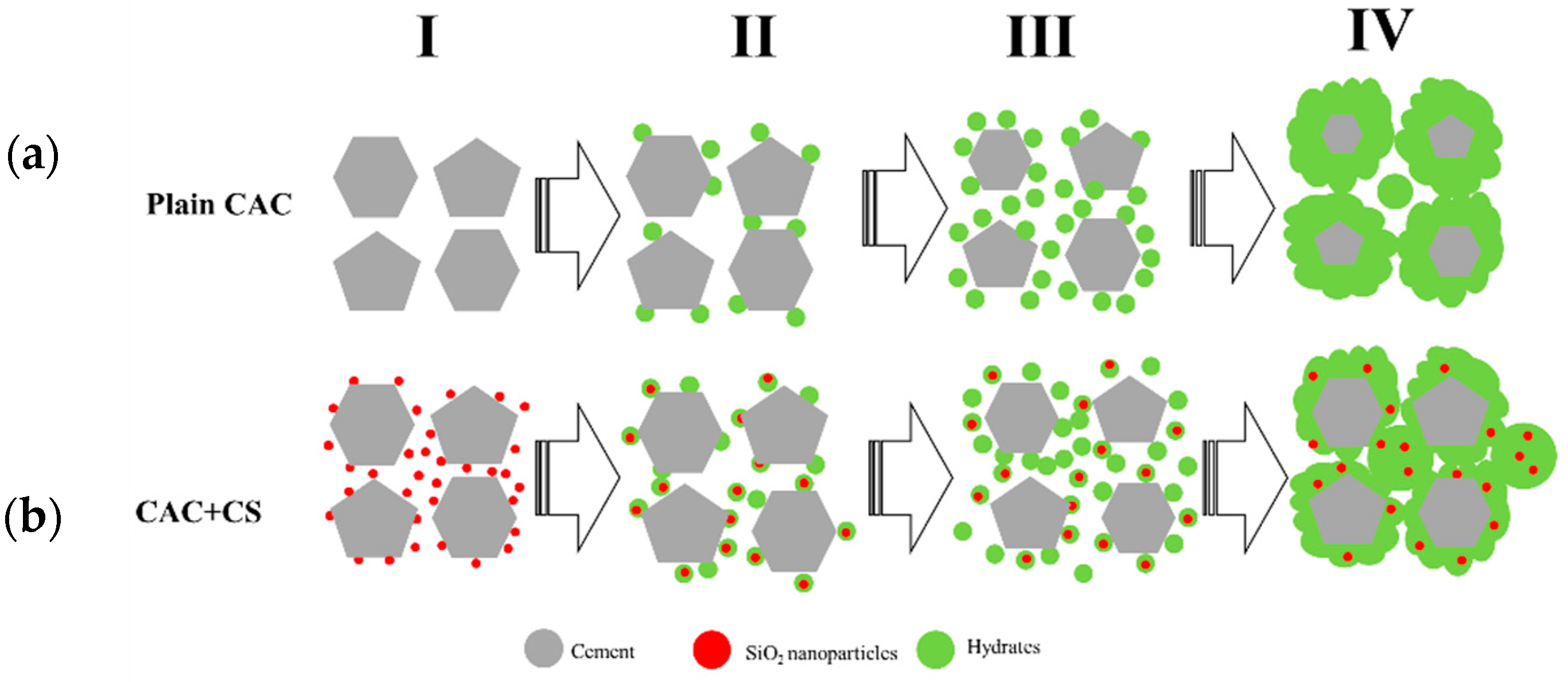3.1. Phase and Microstructure Evolution of Hydrates
Figure 2 shows the XRD patterns of the CAC paste without and with 100 wt.% CS after different hydration times. It can be seen from
Figure 2a,b that the diffraction peaks of hydrates such as C
2AH
8, C
3AH
6 and gibbsite are obvious and intensities of these peaks are increased with hydration time increases. In
Figure 2b, the hydrate tapes are the same as those in
Figure 2a, and the same trend of hydrate peak intensities can be seen with hydration time increases. However, when the hydration time is equal, the intensities of C
2AH
8 and C
3AH
6 peaks in
Figure 2b are weaker than those in
Figure 2a, while the intensities of CA and CA
2 peaks are higher in
Figure 2b.
The hydration process begins with the dissolution of the anhydrous phase and is followed by the precipitation of thermodynamically stable hydrates. Three distinct steps can be identified; dissolution, nucleation and precipitation [
22]. The hydration process is initiated by the hydroxylation of calcium aluminate and followed by the dissolution of Ca in water and the formation of Ca
2+ and Al(OH)
4− species. Hydrates such as CAH
10, C
2AH
8 and C
3AH
6 are precipitated as the solution concentration surpasses the solubility. Therefore, the differences of hydrate XRD patterns in
Figure 2 indicate that the SiO
2 nanoparticles affect the formation of crystalline hydrates, such as C
2AH
8 and C
3AH
6. The low crystallization of CAC hydrates resulting from the colloidal silica is also consistent with reference [
18]. It is noted that Ca
2Al
2SiO
7·8H
2O (C
2ASH
8) is not detected in the CAC paste with CS. This may be due to the poor crystallization of C
2ASH
8. Similar results have been found in other research [
23].
Scanning electron microscopy (SEM) was employed to study the morphology and microstructure of hydrates after 24 h hydration for CAC paste without and with 100 wt.% CS. It can be seen from
Figure 3a that petal-shaped hydrates with a porous structure are formed in the CAC paste without CS. A large amount of well-developed plate-shaped C
2AH
8 and particles AH
3 can be observed in
Figure 3b, and AH
3 particles are inset between the C
2AH
8 compounds. Some C
3AH
6 particles can be seen in the void in
Figure 3c. However, as seen in
Figure 3d, the microstructure of the CAC paste with CS is different to that of the pure CAC paste. It is compact and featureless, and a small amount of C
2AH
8, C
3AH
6 and AH
3 compounds occur at some loose places, as seen in
Figure 3e. The compact structure in
Figure 3d is actually composed of a porous rod-like compound, which contains calcium silicate and aluminate, as shown by EDS in
Figure 3f. The formation of vaterite (CaCO
3) is the result of the reaction between hydrates and ambient CO
2, indicating that the formation of crystalline hydrates also occurs owing to a dissolution/precipitation mechanism. These results are consistent with the XRD patterns in
Figure 2.
The nucleation process only happens around the cement particles in the plain CAC paste, and hydrates are therefore formed around the cement particles [
24], creating the petal-shaped microstructure. However, the SiO
2 nanoparticles are dispersed not only around the cement particles, but also in the pores between the cement particles [
10,
18]. Therefore, due to the nucleation effect and wide distribution of the SiO
2 nanoparticles, the hydrates are formed around the cement particles and pores, leading to the compact structure in the paste. The compact structure also restrains the growth of hydrates, leading to the small amount of hydrates in the CAC paste with CS.
3.2. Thermal Analysis
The Thermogravimetry-Differential scanning calorimetry (DSC-TG) curves for CAC paste without and with 100 wt.% CS after 24 h hydration are presented in
Figure 4.
Figure 4a shows the different peaks for the two kinds of pastes. In detail, it shows four endothermic peaks in the vicinity of 100 °C, 160 °C, 260 °C and 300 °C for the CAC paste without CS. In contrast, no obvious endothermic peaks are observed in the CAC paste with CS. With increasing temperature, the hydrate transformation can be observed as follows. When the temperature is below 21 °C, the main hydrate is CAH
10; as the temperature rises to above 21 °C but below 35 °C, CAH
10 is transformed into C
2AH
8 and AH
3. As the temperature continuously increases to 35 °C, both CAH
10 and C
2AH
8 is transformed into C
3AH
6 and AH
3 [
24,
25]. Therefore, during the heating process in the thermal analysis, the above dehydration processes are generated and their crystal water in the hydrates is lost below 100 °C. While C
2AH
8 decomposes at about 160 °C, AH
3 loses its molecules in the form of water vapor at 260 °C, and C
3AH
6 decomposes at 300 °C by the following Equations (1)–(3).
However, no obvious endothermic peaks in the CAC paste with CS can be ascribed to the exothermic reaction of SiO
2 nanoparticles during the heating process. The SiO
2 nanoparticles are apt to agglomerate to reduce the surface energy in the heating process, releasing a lot of heat. The heat releasing capacity for the SiO
2 nanoparticle agglomeration may be much more than the heat absorption capacity of the hydrate decomposition [
22], so exothermic peaks instead of endothermic peaks can be seen in
Figure 4a.
The TG curves in
Figure 4b show that the weight loss of plain CAC paste is 27.1%, which is higher than that of CAC paste with CS. Because the free water in the pastes has been volatilized in the freeze drying process, the weight loss of the paste is mainly due to the dehydration of the hydrate; therefore the TG curves indicate that there are few hydrates in the CAC paste with CS. In other words, the late stage of the CAC hydration process is inhibited by CS, leading to fewer hydrates in the paste.
3.3. FT-IR Spectra Analysis
The FT-IR spectra of CAC paste after 24 h hydration are given in
Figure 5. The results show the presence of bands located at 3628–341 cm
−1, which is assigned to the hydrates. It is obvious that the intensity of the absorption bands is decreased when CS is added. The presence of a band at 1638–1664 cm
−1 is due to the stretching and bending vibration of the water lattice in the hydrated calcium aluminate [
26]. Its intensity decreases when CS is added because the amount of hydrated calcium aluminate is decreased. The band at 1421–1433 cm
−1 is the C-O bond stretching of CO
32−, resulting from the carbonation of hydrated aluminate. Exposure of cement pastes to air results in a very quick carbonation [
27]. The sharp absorption band at 1117 cm
−1 is the bending vibration of Si-O-Si. The bands at 1013 and 719 cm
−1 are attributed to the bonds vibration of C
2ASH
8 [
28]. The signals at about 680 and 640 cm
−1 are assigned to AlO
6 vibrations. The band at 804 cm
−1 is related to the Si-O vibration in the amorphous SiO
2. The band at 471 cm
−1 is due to the bending vibration frequency of the Si-O bond of the SiO
42− tetrahedral, and an absorption band associated with the Si-O-Al vibration lies at 542 cm
−1, which are well defined [
29]. The band observed at about 422 cm
−1 is the vibration of C
2AH
8/CAH
10.
It is noted that the intensities of the absorption bands are decreased as CS is added into the paste, because the phases of non-ordered structures could cause the band width to increase and intensity decrease. This result is in agreement with the XRD patterns seen in
Figure 2. The bands at 1013 and 719 cm
−1 confirm the formation of C
2ASH
8, indicating that the silica nanoparticles have reacted with CAH10/C
2AH
8. The stable hydrate C
2ASH
8 is in favor of mitigating the strength lost during hydrate conversion.
3.4. Electrical Conductivity Analysis
Electrical conductivity can be used as an indication for setting characteristics as well as structural changes of the hardened pastes. To understand the ion concentration variations and structural changes during the hydration process, the electrical conductivity curves of pastes with different CS contents are shown in
Figure 6. It is clear that there are four stages for the electrical conductivity curves. The electrical conductivities increase rapidly during the first stage I, and are then stable during the second stage II. After that, the electrical conductivities decrease at the third stage III, and finally reach their lowest value and stay stable during stage IV. The increase of electrical conductivity in the initial period of hydration is mainly due to the dissolution of CA grains according to the following Equation.
In the first minute of hydration, a high concentration of Ca
2+ and Al(OH)
4− is liberated into the paste [
24,
30]. Therefore, the increase of ion concentration and mobility (Ca
2+ and Al(OH)
4−) in the pastes improves the electrical conductivity during the initial hydration process. These ions are readily absorbed to form a thin layer of hydration products, which then creates an envelope around the unhydrated cement grains. This envelope consists of electrical double layers, and it absorbs calcium ions and counter ions, which decreases the increments of ion number and mobility [
31] and obtains the maximum values of electrical conductivity. This period lasts almost 1 h. After that, the rate of ion dissolution and nucleation reaches a balanced state, and the electrical conductivity of the pastes is then stable at this second stage. During the third period of hydration, the formation and accumulation of various kinds of hydrates result in a remarkable consumption of ions leading to a sharp decrease in the electrical conductivity of the pastes. The hydration process is almost completed in the fourth period and the hydration compounds are formed, so the electrical conductivity is therefore stable.
It is worth noting that the maximum value of the CAC paste with CS is almost 3800 μS⋅cm
−1, which is much higher than that of the plain CAC paste (2400 μS⋅cm
−1). Further, the most interesting feature is that there are two peaks in the electrical conductivity curves as CS is added into the CAC paste. Therefore, it is assumed that the high electrical conductivity of the paste with CS can be attributed to the effect of SiO
2 nanoparticles in CS. The cement dissolution keeps the Ca
2+/Al(OH)
4− ratio in its equilibrium condition. However, the SiO
2 nanoparticles can be coagulated in the CAC paste due to the existence of Ca
2+, leading to the consumption of Ca
2+ in the solution [
32]. This coagulation process increases the concentration of Al(OH)
4− according to Equation (4), thus the maximum electrical conductivity value is increased. Further, the hydration process during the late stage is retarded due to the addition of CS, which will be mentioned in the following results. Therefore, the porosity is large and the pore structure connectivity is integrity, which is in favor of the transportation of Ca
2+ and Al(OH)
4− in the pastes and increases the electrical conductivity. The Na
+ as a stabilizer in the CS is also beneficial for increasing the mobility and concentration of ions and enhancing the electrical conductivity of the paste. The second peak of the electrical conductivity curves may be due to the osmotic pressure development around the cement grains. A gel layer is formed around the CA grains in the hydration process. On progressive hydration, the osmotic pressure of the gel layer increases gradually and breaks the gel layer, leading to ions going into the solution [
33].
In addition, the proportion of added CS affects the initial electrical conductivity values and the location of the maximum value peaks, as shown in
Figure 6. It can be seen that the initial electrical conductivity values are increased gradually as CS contents increase, indicating that the rate of initial hydrolysis of CAC is increased. Further, the locations of the maximum value of electrical conductivity shifting to high position can be attributed to the accelerating effect of CS during the early stage of the hydration process.
3.5. Hydration Heat and Kinetic Model Analysis
The hydration heat of cement pastes in isothermal conditions is used as an indicator of the advancement of hydration reactions. The heat evolution and heat flow curves of cement pastes without and with CS are shown in
Figure 7. It can be seen from
Figure 7a that the hydration heat of plain CAC paste is 475.16 J/g, which is almost equal to the hydration heat of the paste with 20 wt.% CS (483.07 J/g, joules per gram of cement). However, as the CS contents are increased to 60 wt.% and 100 wt.%, the hydration heat capacities are decreased to 371.94 J/g and 368.99 J/g, respectively. The lower hydration heat of the paste can be attributed to the hydration degree decreasing of CAC. Owing to the nucleus of SiO
2 nanoparticles around the cement particles, the hydrates covered with cements are dense during late stage of the hydration process. As more CS is added, the hydrates covered with cement particles are denser during the late stage (including the deceleration and stable periods) of the hydration process, which inhibits the water molecular and ion transportation between the unhydrated cement and paste solution. Another probability is that a considerable amount of free water is constrained in the pores of silica nanoparticle aggregates during the agglomeration process, resulting in the reduction of water for hydration of the cement [
34]. Further, the formation of C
2ASH
8 also leads to the reduction of water in the paste, decreasing the hydration degree of CAC [
18]. Therefore, the heat releasing content of hydration is decreased as CS is added.
The heat flow curves in
Figure 7b show that there are two peaks for all samples. The two exothermic peaks are located at 1 h and 10 h for plain CAC, respectively. However, the intensities of the two exothermic peaks for the pastes with CS are higher, while the positions of corresponding peaks are lower than those of the plain CAC paste, indicating that the hydration exothermic rate for pastes with CS hydrates is high. The cement hydration process is a heat releasing process, which usually contains two peaks. The first peak is relevant with the wetting heat, dissolution saturation and nucleus formation of cement as the cement is in contact with water; the second is due to the precipitation of the hydrates [
17,
35]. When CAC cement is in contact with water and CS, Ca
2+,OH
−,Al(OH)
4− ions are produced, and Na
+, SiO
32− are also presents in the CS. The SiO
2 nanoparticles begin to play the role of a nucleus and consume the Ca
2+, making the Equation (1) moving to the right side. What’s more, the silica nanoparticles shorten the induction period of the cement paste through reducing the concentration of calcium ions [
27,
32]. Therefore, the first heat releasing peak appears earlier in the paste with CS.
The degree of hydration, defined as the relative amount of hydrated cement, is often measured experimentally by an isothermal calorimeter. The degree of hydration α(t) can be computed as a function of the heat release
Q(t) and the heat release when complete hydration is reached
Q∞[
17], as shown in Equation (5).
The hydration degree curves with CS contents are shown in
Figure 7c. It can be seen that the induction period of plain CAC paste is almost 7 h, much longer than that of pastes with CS (less than 2 h). The hydration rate curves in
Figure 7d obviously show that the hydration rate is greatly increased with addition of CS, especially for the first heat releasing process, suggesting that the hydration rate at the early stage of the hydration process is greatly prompted by silica nanoparticles.
The Krustulovic-Dabic kinetic model assumes that there are three basic hydration processes; nucleation and crystal growth (NG), interactions at the phase boundaries (I) and diffusion (D). It is suggested that these three processes may take place simultaneously, but the whole hydration process is controlled by the slowest one. NG dominates the initial stage of hydration, and, as the reaction continues, I or D replace NG as the dominant process. The following Krustulovic-Dabic Equations and the corresponding logarithmic Equations (6a)–(8b) are usually applied to describe the hydration kinetics [
36,
37].
D process:
where n is the value of the Avrami exponent that relflects the nucleation and growth mechanism details. K
NG, K
I and K
D are the reaction rate of the NG, I and D processes, respectively.
Using the data of α and t listed in
Figure 7a,b, and based on the Equations (6b)–(8b), the curves of dα/dt versus α can be determined and are shown in
Figure 8. The α
1 and α
2 in the curves represent the transition points from the NG to I process and from the I to D process, respectively, which are listed in
Table 3. The curves in
Figure 7 suggest that the initial stage of hydration is dominated by the NG process because there is sufficient water and less hydrates at this stage. As the hydration reaction continues, the amount of hydrates increases resulting in difficult migration environment for ions. Thus, the hydration process is transformed into the diffusion-dominated stage (I), and lastly the diffusion stage (D) controls the hydration rate. However, there is a slight difference in the effect of CS on controlling the hydration rate of cement, as shown in
Table 3. It is shown that the first transition point of α
1 increases with increasing CS content, while the second transition point of α
2 decreases gradually. The α
1 and α
2 of pure cement paste are 0.1 and 0.5, respectively. When 100% CS is added, the α
1 and α
2 vary to 0.14 and 0.46, respectively. The increase in α
1 indicates that the SiO
2 nanoparticles promote the hydration rate in the NG process period, and the extension of the NG process suggests that the SiO
2 nanoparticles develop well as hydrate nuclei. While the decrease in α
2reveals that the phase boundaries stage (I) is shortened, which the hydration reaction transformed into diffusion stage (D) earlier occurs. This transformation of the dominant reaction is due to the nucleus role of SiO
2 nanoparticles. As can be seen in
Figure 3c,d, the microstructure of the paste with CS is dense, which inhibits the water molecule and ion immigration, so the dominant hydration reaction earilytransforms into diffusion stage. Thus, the SiO
2 nanoparticles promote the hydration degree during the NG process stage and decrease the hydration degree at the phase boundaries stage, and therefore the hydration reaction earlier transforms into the diffusion stage.
3.6. 29Si MAS NMR Spectroscopy
Solid-state nuclear magnetic resonance spectroscopy (NMR) is one of the most powerful tools for studying the reactions of cement hydration. Various forms of Si-O bonding are shown in
Figure 9. The basic tetrahedral unit, (SiO
4)
4−, is referred to in this field as a Q
0 unit, where the superscript on the Q refers to the number of (SiO
4)
4− attached to the central (SiO
4)
4− unit. Q
1 refers to a dimer and Q
2 represents silicon atoms within a polymeric chain of (SiO
4)
4− units. Q
3 and Q
4 correspond to silicon atoms from which increasingly complex degrees of chain branching occur.
The local environments of Si atoms in hydrated pastes are determined by
29Si MAS NMR spectroscopy, as shown in
Figure 10. The spectra in all the samples analyzed are formed by six peaks at ~−110, −97, ~−82, ~78 ppm and two peaks at ~60 and 65 ppm. The partial dissolution of the silica particles produced depolymerized species that could interact with Ca and Al ions. The
29Si spectrum of the amorphous silica displays a single peak at −110 ppm, which is associated with tetrahedral Si in Q
4[Si(OSi)
4] environments (
Figure 9). The intensity of the −110 ppm peak is important in the hydrated compounds, as it indicates that a considerable part of the silica has not reacted. The peak at approximately −97 ppm corresponds to Q
3[Si(OSi)
3OH] environments at the surface of the silica nanoparticles [
38,
39]. The amount of unreacted silica is estimated from the relative intensity of the −110 and −97 ppm peaks, which are associated with Si atoms in Q
4 and Q
3 environments. The formation of [SiO
4]
4 groups in the hydrogarnet is ascribed by the presence of the
29Si NMR peak at ~−60 and −65 ppm. These signals correspond to isolated [SiO
4] groups in Q
0(4Al) environments. It can be seen from
Figure 10 that the intensities of Q
0 peaks at ~−60 and −65 ppm are increased with hydration time extension, suggesting that the amount hydrates in hydration reactions increases, which is consistent with the FT-IR spectra results that show Si-O-Al vibration in the hydrates.
3.7. Hydration Mechanism of CAC
Figure 11 displays the schematic diagram of cement hydration processes according to the above results and analysis. For the cement without CS the hydration process is composed of four periods; the induction period, acceleration period, deceleration period and stable period [
17,
24]. As can be seen in
Figure 11a, after the dissolution of cement in water, the crystal nucleus of hydrates is formed at the surface of the cement during the induction period. Next, the hydrates are precipitated during the acceleration period. Owing to hydrate coverage at the surface of the cement during the hydration process, the dissolution process of cement is inhibited in the deceleration period. When the cement particles are covered with dense hydrates and the water is consumed, the hydrate process is dominated by diffusion and the stable period is initiated.
However, the cement particles are surrounded with silica nanoparticles when they are mixed with CS, as shown in
Figure 11b. These silica nanoparticles are the nucleus point for hydrates, so the hydration process are conducted fast to acceleration period [
1,
4,
10], therefore the hydration heat and electrical conductivity of cement with CS are higher than those of cement without CS during the early stage of the hydration process, as shown in
Figure 6 and
Figure 7. AS the hydration proceeds, the cement particles are covered with dense hydrates, as shown in
Figure 3, so the dominant hydration reaction is transformed into the diffusion stage earlier as shown in
Figure 8.
The incorporation of nanoparticles in CAC cement was investigated in previous studies, which showed that nanoparticles accelerate the cement hydration due to the nucleus effect. However, in light of all the results in this work, when hydrated, SiO
2 nanoparticles only accelerate the early stage of hydration, but inhibit the late stage of hydration for CAC cement. Owing to the nucleus effect of SiO
2 nanoparticles, a gel layer forms around CAC grains during the early stage of hydration [
33]. The gel layer grows dense as hydration continues, and inhibits the transportation of water and ions between the solution and cement grains, resulting in the hydration degree reducing. Because of this, the hydration degree at the NG (nucleation and crystal growth) process stage is promoted, while it is limited at the phase boundaries stage, and the diffusion stage in the hydration reaction is brought forward. This suggests that the nanoparticles with high specific area facilitate an effective role of obtaining a cement paste with a highly rapid coagulation rate.
















